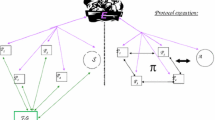Abstract
Proxy re-signature is a powerful cryptographic primitive, in which a proxy acts as a translator converts Alice’s signature into Bob’s signature by using the re-signature key. Proxy re-signature is a very useful tool for the interoperable DRM architecture and the passed path proof in cloud computing. However, the number of cloud users is very huge, so it is unsuitable to construct PKI in cloud computing. Moreover, the cloud users are usually mobile devices, which are constrained with processing and power limitations, and pairing is a very costly operation to them. Thus, ID-based proxy re-signature without pairing is an attractive issue for the applications in cloud computing. In this paper, based on Chai et al’s ID-based signature from quadratic residues, we propose the first unidirectional and single-use ID-based proxy re-signature, which is existential unforgeable in the random oracle model based on the factoring assumption.
Similar content being viewed by others
References
Blaze, M., Bleumer, G., & Strauss, M. (1998). Divertible protocols and atomic proxy cryptography. In EUROCRYPT 1998. LNCS (Vol. 1403, pp. 127–144).
Ateniese, G., & Hohenberger, S. (2005). Proxy re-signatures: New definitions, algorithms, and applications. In ACM CCS 2005 (pp. 310–319).
Libert, B., & Vergnaud, D. (2008). Multi-use unidirectional proxy re-signatures. In ACM CCS 2008 (pp. 511–520).
Shao, J., Feng, M., Zhu, B., Cao, Z., & Liu, P. (2010). The security model of unidirectional proxy re-signature with private re-signature key. In ACISP 2010. LNCS (Vol. 6168, pp. 216–232).
Yang, P., Cao, Z., & Dong, X. (2011). Threshold proxy re-signature. Journal of Systems Science and Complexity, 24, 816–824.
Shamir, A. (1984). Identity-based cryptosystems and signature schemes. In Proceedings of CRYPTO 84, volume 196 of lecture notes in computer science (pp 47–53). Springer.
Shao, J., Wei, G., Ling, Y., & Xie, M. (2011). Undirectional identity-based proxy re-signature. In Proceeding of IEEE ICC 2011 (pp. 1–5).
Lauter, K., Montgomery, P. L., & Naehrig, M. (2010). An analysis of affine coordinates for pairing computation. In M. Joye, A. Miyaji, & A. Otsuka (Eds.), Pairing 2010. LNCS (Vol. 6487, pp. 1–20). Heidelberg: Springer.
Chai, Zhenchuan, Cao, Zhenfu, & Dong, Xiaolei. (2007). Identity-based signature scheme based on quadratic residues. Science in China Series F: Information Sciences, 50(3), 373–380.
Shoup, V. (2005). A computational introduction to number theory and algebra (p. 534). Cambridge: Cambridge University Press.
Bellare, M., & Palacio, A. (2002). GQ and Schnoor identification schemes: Proofs of security against impersonation under active and concurrent attacks. In Crypto. LNCS (Vol. 2442, pp. 162–177).
Acknowledgements
This research is supported by the National Natural Science Foundation of China under Grant No.61373006,61672016.
Author information
Authors and Affiliations
Corresponding author
Rights and permissions
About this article
Cite this article
Wang, Z., Xia, A. & He, M. ID-based proxy re-signature without pairing. Telecommun Syst 69, 217–222 (2018). https://doi.org/10.1007/s11235-018-0458-9
Published:
Issue Date:
DOI: https://doi.org/10.1007/s11235-018-0458-9




